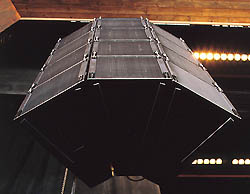
Obviously, the faster that a given loudspeaker responds, the more accurate it will sound. However, a very fast loudspeaker may not sound as “warm” or desirable as a less accurate one. That’s because we’re schooled by a lifetime of listening to loudspeakers that exhibit a relatively slow transient response, especially in the very low frequencies.
In listening tests, many people prefer a slow subwoofer to a fast one, because it sounds like it’s “filling out” the bottom end. Moreover, most musical instruments do not exhibit uniform transient response. The 9-foot bass strings of a grand piano do not start and stop anywhere near as quickly as the 6-inch strings in the upper register – by several orders of magnitude. Nor does a tympani exhibit the same transient response as a pair of claves.
It’s therefore a common human response to desire a slower transient response in the low end, while preferring a faster transient response in the high frequencies, particularly in respect to naturally occurring acoustical events. This works out well because a heavy 21-inch woofer cone is never going to exhibit the same transient response as a 1-inch soft-dome tweeter.
If you wish to experience music reproduced with extremely low distortion, highly uniform and precise transient response, and near-perfect phase/frequency response, listen to electrostatic headphones, such as the STAX line. With a diaphragm that’s only 3 microns thick (3 microns = 0.000118 of an inch) and weighs almost nothing, electrostatic headphones are a great way to train your hearing skills.
The clarity and evenness of response will probably never be matched by a PA loudspeaker, because it must provide far greater output power in order to be useful. And that brings us to the last two factors.
Factors 7-8: Power Output & Dispersion
These two are closely related, because one is partially the function of the other. High power systems typically exhibit narrow, or at least controlled, dispersion in one or both axes. Examples are line arrays and long-throw horns.
When acoustic energy is concentrated, it increases in intensity, though often at the expense of higher distortion and less response uniformity. Couple this with drivers that are engineered to be powerful rather than uniform and linear, and the sonic quality can suffer.
Conversely, a smaller loudspeaker might exhibit nearly perfect response in all other categories, but only be capable of providing enough power to function as a nearfield monitor with no dispersion control, a poor candidate for sound reinforcement in large, reverberant spaces.
Power output capability and dispersion play one of the largest roles in how useful a loudspeaker might be – hence the first spec on many contract riders is often system wattage, or SPL at a certain location, usually the front of house console. Although neither will give you a clue as to how the system might actually sound, and whether it’s properly covering the seating plan, it’s still a prevailing demand made by production managers and sound engineers.
Conclusion
What happens when a loudspeaker falls short of achieving reasonable performance in one or more of these factors?
—It may sound cloudy and unclear.
—It may favor one musical register (or even one note) over others.
—It may hurt the ears with excessive distortion.
—It may perform well at low levels but poorly at high levels.
—It may not cover the audience well, especially on the fringes.
—It may cover the audience too well, sending too much energy toward sides, ceilings, and rear walls, causing undue room excitation.
—It may simply not get loud enough to handle the show’s requirements.
—And, it may do much…or even all of the above!
Ken DeLoria is senior technical editor for Live Sound International and ProSoundWeb, has had a diverse career in pro audio over more than 30 years, including being the founder and owner of Apogee Sound.

